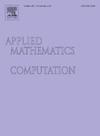完全分割图中的彩虹独立三角形
IF 3.4
2区 数学
Q1 MATHEMATICS, APPLIED
引用次数: 0
摘要
对于两个图K和H,其中K包含H作为子图,则K中H的反拉姆齐数,记为AR(K,H),是使得K存在一个不包含彩虹H的K边着色的最大整数K,设2C3表示两个独立三角形的并。本文给出了s≥1、n≥4和s+n≥6时,AR(Ks - +Kn,2C3)的取值。本文章由计算机程序翻译,如有差异,请以英文原文为准。
Rainbow independent triangles in complete split graphs
For two graphs K and H, where K contains H as a subgraph, the anti-Ramsey number of H in K, denoted by , is the largest integer k such that there exists a k-edge-coloring of K containing no rainbow H. Let denote the union of two independent triangles. In this paper we obtain the value of for and .
求助全文
通过发布文献求助,成功后即可免费获取论文全文。
去求助
来源期刊
CiteScore
7.90
自引率
10.00%
发文量
755
审稿时长
36 days
期刊介绍:
Applied Mathematics and Computation addresses work at the interface between applied mathematics, numerical computation, and applications of systems – oriented ideas to the physical, biological, social, and behavioral sciences, and emphasizes papers of a computational nature focusing on new algorithms, their analysis and numerical results.
In addition to presenting research papers, Applied Mathematics and Computation publishes review articles and single–topics issues.

 求助内容:
求助内容: 应助结果提醒方式:
应助结果提醒方式:


